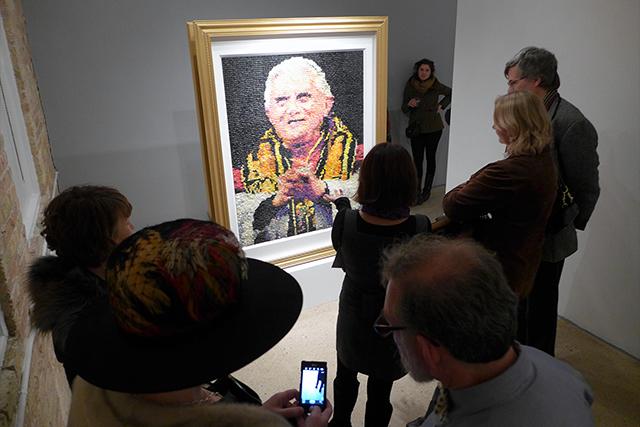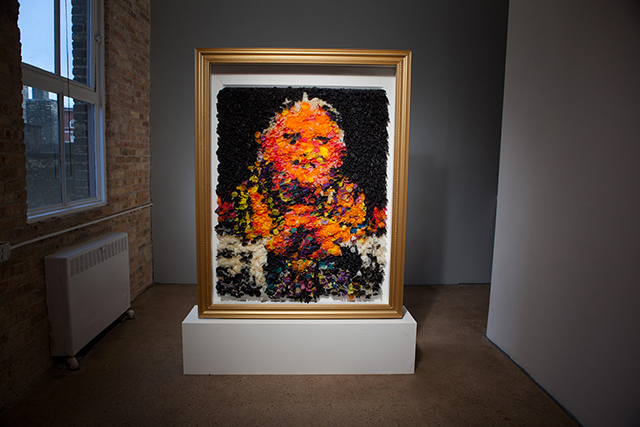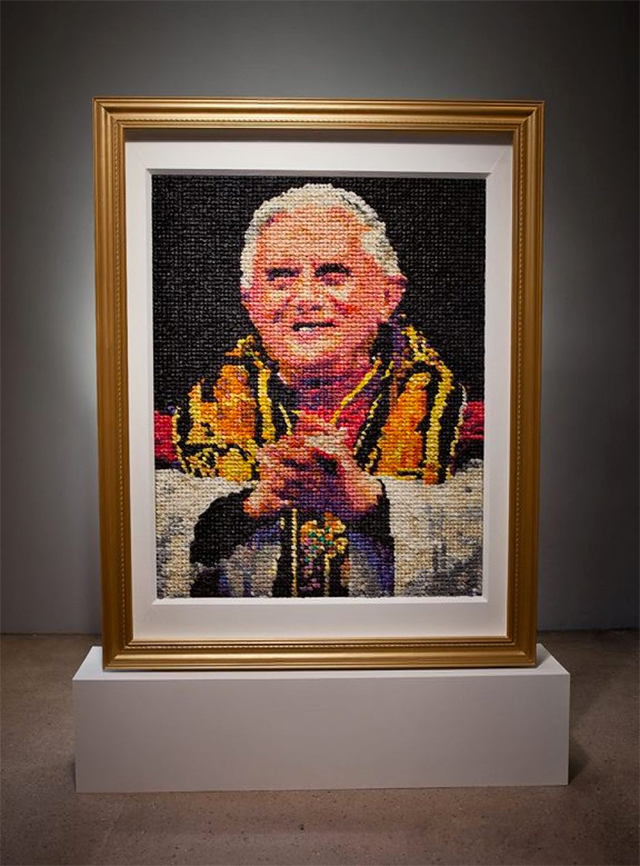July 2, 2015

MILWAUKEE — It’s not unusual for a work of art to cause outrage, especially if it dips into the tender zones of race, gender, or religion. It is no surprise, then, that news of the Milwaukee Art Museum (MAM) acquiring a seven-foot-tall, double-sided portrait of Pope Benedict XVI woven from 17,000 condoms has caused consternation, 500 comments within the first day of a local newspaper article online, national coverage, and threats from museum members, donors, and docents to withdraw support.
Big deal. This is the art world, and it’s par for the course. Controversy is as much a part of art history as rabbit skin glue.
In a post-Mapplethorpe landscape, we know the routine — although of course it goes back further than that. CARAVAGGIO was considered vulgar for his mixing of real life models into religious scenes in the 17th century. One hardly needs to mention ANDRES SERRANO’s “Piss Christ” controversy in 1989 and the subsequent CHRIS OFILI “Holy Virgin Mary” scandal of 1999. More recently, the Hide/Seek exhibition of 2010–11, co-curated by Jonathan D. Katz and David C. Ward and shown at the National Portrait Gallery in Washington, DC, caused an uproar, not because it was a brilliant revisionist history of the role gay artists played in Modernism, but because one video by DAVID WOJNAROWICZ showed ants crawling on a crucifix. The video was removed from the exhibition.
Religious purists, in efforts to protect their sanctity, rise up in waves of predictable indignation. The arguments are generally reactionary and simple-minded, disregarding the artist’s investment of thought, time, and professionalism in a complex, socially engaged attempt to communicate the way only art can — via a premise rather than polemics. The ‘Condom Pope’ has been quickly dismissed by an internet public as a stunt, an offense and a childish prank to garner public attention.
Archbishop of Milwaukee Jerome E. Listecki wrote:
An artist who claims his or her work is some great social commentary and a museum that accepts it, insults a religious leader of a church, whose charitable outreach through its missionaries and ministers has eased the pain of those who suffer throughout the world, must understand the rejection of this local action by the believers who themselves have been insulted.
William A. Donahue, of the Catholic League, has also chimed in.
“This is yet another diversionary tactic of a right wing increasingly aware it is on the wrong side of history,” said curator Jonathan Katz. “Borrowing a language of discrimination from the left, they try to make it seem as if they are the wounded party. But tell me, who has been the subject — the continuing subject, I might add — of centuries of legal and and physical abuse aided and abetted by religion?”
But it seems as if everyone loses during these flare-ups. At the same time that conservatives defensively misinterpret the meaning and value of the work, the more liberal art world confuses the viral spotlight for empowerment. The valuable message of the work becomes muffled by the sensationalism of the controversy. The ‘Condom Pope’ has not even gone on view at the museum yet. The MAM’s permanent collection is currently closed for remodeling and reinstallation and will open in November with the Pope tucked between CHUCK CLOSE’s “Nancy” (1968) and DUANE HANSON’s “Janitor” (1973), a rather clinical contextual nod to photorealism and the portrait — a safer positioning than within the more amorphous contemporary collection.
Eggs Benedict, Latex embroidery on steel mesh, wood, plexiglass, 83”x 60”x 14”, 2013, In the permanent collection of the Milwaukee Art Museum
The artist NIKI JOHNSON (b. 1977, Wisconsin) made this double-sided portrait of Pope Benedict XVI, actually titled “Eggs Benedict,” out of 17,000 multicolored condoms. The piece is a response to a statement made by the conservative German former Pope in 2009 that condom use would not stem the spread of AIDS in Africa. In all of her work, JOHNSON, who earned her MFA in 2012 from the University of Wisconsin-Madison, is interested in feminist and social issues and how the media disseminates information and shapes opinion.
“Eggs Benedict” was first exhibited in 2013 at my art gallery in Milwaukee, Portrait Society, a space dedicated to reexamining issues related to the genre of portraiture. The novelty of this work and the promotional acumen of the artist caused a viral, international response then, with the ‘Condom Pope’ being written about nearly worldwide. Locally, it received positive print and television media attention; the majority of international attention was positive as well. Visitors to the gallery, both Catholic and not, applauded the technical finesse of the piece as well as its respectful portrayal of the Pope. His image, culled from a newspaper photograph, is representational. JOHNSON wove the condoms through a mesh, much like a rag rug, to achieve the effect, acknowledging the process of weaving and its relationship to traditional women’s craft. She sometimes doubled two condom colors to achieve a more complex palette. The back of the piece shows the dangling ends of the condoms and appears as an almost abstract composition.

During its debut at the gallery, visitors lingered and wanted to converse about the piece. Strangers spoke to strangers about issues ranging from birth control and the role of church and state in contraception and abortion to the stigma regarding condoms (it’s still hard to talk to your teenagers about them) and HIV prevention. It became a selfie zone. It was within this context that the Milwaukee Art Museum accepted the sculpture into its collection. “We did not think the work would spark this much interest,” MAM Director Dan Keegan told Hyperallergic. “However, we did anticipate that it would stimulate conversation and discussion. That’s what good art does.”
But beyond the yawningly predictable controversy as “Eggs Benedict” enters the public sphere is another story about how it got there and perhaps about why more politically charged, socially engaged work so infrequently makes it into the permanent collections of art museums. As curator Jonathan Katz told Hyperallergic, “The art world has long been party to a significant confusion: it mistakes avant-garde style for avant-garde politics and then claps itself on the back for being so progressive. But the rare art that dares to address politics is almost always denied a place at the table until enough decades have passed to blunt its bite.”
To get a place at the table these days, it doesn’t take a village; it takes a liberal patron. And in Milwaukee, as elsewhere, they are precious few.
Joseph Pabst, descendant of the Pabst Brewing Co. family, has been involved in LGBTQ organizations and supported AIDS research for more than a decade. But his love of art and degrees in art history and design have inspired a different kind of activism too. Pabst understands the role that art plays in culture, absorbing and reflecting the conditions of its time, both directly and indirectly. He knows he can use his financial ability and passion for contemporary issues to ensure that the underrepresented, the victimized, and the oppressed receive a place within the regulated vaults of the public art world. When the Milwaukee Art Museum hosted an exhibition of more than 40 historic American quilts from the Winterthur Collection in 2010, for example, Pabst conceived of and funded a parallel exhibition of nine NAMES Project AIDS Quilts, which was shown around the corner . In 2011, after seeing a TARYN SIMON exhibition at the Milwaukee Art Museum, Pabst purchased her photograph of a vial of live HIV virus and gifted it to MAM with the stipulation that it be shown every year on World AIDS Day. He also purchased a suite of photographs of gay hate crime murder sites by artist PAUL BAKER PRINDLE and gave them to the regional Museum of Wisconsin Art.
It would have been unlikely that the Milwaukee Art Museum would have put forth $25,000 to purchase “Eggs Benedict.” When Pabst heard that the gallery was considering selling the work to a private collector, he stepped in and advocated that because of the potency of the piece’s message, it must be placed in a public institution, to “reach the greatest number of people … to do the most good,” he commented at the time. Pabst offered to buy the work and gift it. After a national search for a museum recipient, the MAM agreed. While both the Leslie Lohman Museum of Gay and Lesbian Art and the Museum of Sex in New York expressed interest, Pabst preferred to see it housed in a museum with a more general audience as well as in the city where he lives.
“I’m interested in many issues, including art, LGBT issues, HIV and AIDS, and issues of violence, including sexual violence,” Pabst said. “It’s ironic that the church and I should share such similar concerns. How could I not buy this piece when it covers a parallel social spectrum?”
Milwaukee, the city of beer, cheese, cream puffs, and bratwurst, has been under a conservative assault for four years with Republican Governor Scott Walker in office. Most of the news coming from here has been bad. Walker has undermined the unions, cut funding for education, advocated for new abortion constraints, and loosened gun laws in a city that is replete with violent crime. It is heartening that a scion of the city’s early brewing pioneers is working to keep earnest conversation, debate, and inquiry an integral part of the local culture.
“I’m thrilled that the artwork is doing what it should do: prompting people into a conversation — one that I hope is productive,” Pabst said. “This is a historic moment that is taking place in Milwaukee, Wisconsin, for the world to see. A work of art is stirring a global conversation. Hopefully, once the piece is on public view, it will stimulate the conversation that was intended by the artist and the patron. That conversation is about HIV/AIDS.”
Debra Brehmer
Hyperallergic
***
PAUL FRYER (April 8, 2014)
La Nona Ora (1999) de MAURIZIO CATTELAN (February 12, 2013)
Destruction de «Piss Christ»: «Je ne m’y attendais pas, surtout en France» (April 18, 2011)
A Fire in My Belly ‘Original’ (1986-87) by DAVID WOJNAROWICZ (December 22, 2010)
Ant-covered Jesus video removed from Smithsonian after Catholic League complains
(December 2, 2010)


